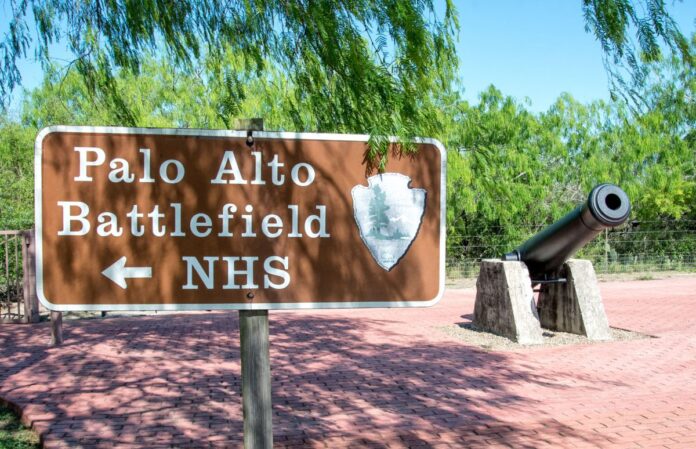HARLINGEN — The crackle of musket fire and the boom of cannon have returned to the Rio Grande Valley on Saturdays.
The Palo Alto National Battlefield Historical Park has begun its cool-weather, living history lessons which will continue on the first Saturday of each month through May.
The free and kid-friendly event includes re-enactors dressed in period military uniforms of the U.S. and Mexican armies, along with a generous helping of still-operational historic weapons ready to be fired.
“We do flintlock musket demonstrations and then, provided we have enough crew members, we also have a period artillery piece that we fire as well,” Park Ranger Daniel Ibarra said.
“The demos are kind of a way to catch peoples’ interest, and then we delve into the stories of Palo Alto battlefield and the U.S.-Mexican War,” he added.
The battlefield, which was established by the National Park Service in 1978, commemorates the military action which began there on May 8, 1846, and continued for two years in what is known as the U.S.-Mexican War.
Ibarra said many visitors come for the weapons demonstration, but become interested in learning about the daily lives of soldiers from both sides who were fighting on the frontier.
“As far as the battlefield goes, these are two armies where most of the soldiers who are making up those armies are pretty far away from home,” he said. “There’s not much around at the time.
“There was no Brownsville at the time, obviously,” he added. “You only had Matamoros and then you had to go clear up all the way to Corpus to get to any major settlement.”
One historical fact we would now call “cultural appropriation” involved the form and function of the lowly soldier’s canteen.
Mexican troops were issued a gourd canteen that was significantly better, given the hot Valley climate, than the U.S. Army-issued water jug.
“For the U.S. soldiers, the majority of them were issued metal canteens by the U.S. Army, and some of them were issued wooden canteens,” he said. “But as they got into the area down here, especially the ones who made their way down into northern Mexico, they noticed that the canteen of choice was actually the gourd canteen.
“They discovered that it actually kept the water a whole lot cooler than the metal canteen,” he said. “So a lot of them switched and started adopting gourd canteens.”
Being on the frontier also led to a more casual approach to military regulations, Ibarra said.
“It wasn’t just the canteen,” he said. “Especially with (Major Gen. Zachary) Taylor’s army, the dress code was fairly relaxed and so you had, maybe not the privates, but for sure the officers taking some liberties with their uniforms.
“There’s an account of Taylor, when he’s down in the area of Monterrey, he’s actually wearing a serape,” Ibarra said. “It makes sense, if you’re going to be down in the area, to dress appropriately, especially for the weather.”
Weather is the only thing that will postpone Saturday demonstrations and re-enactments at Palo Alto National Battlefield Historic Site.
IF YOU GO
WHERE : Palo Alto National Battlefield Historical Park, 7200 Paredes Line Road, Brownsville
WHEN : Saturdays at 10 a.m., through May
WHAT : Sights and sounds of battle, including firing of period weapons and cannon
WHY : The event demonstrates weaponry, uniforms and the daily lives of U.S. and Mexican soldiers in 1846
COST : Free and kid-friendly
CONTACT : 956-541-2785 ext. 333




